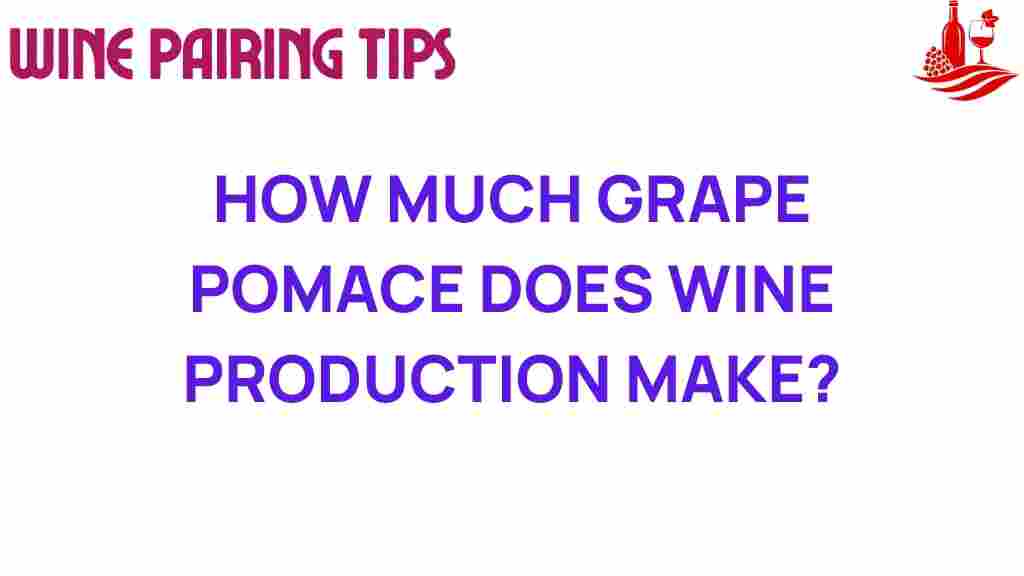The Hidden Treasure: How Much Grape Pomace is Left After Winemaking?
In the world of winemaking, the focus often lies on the exquisite flavors and aromas of the finished product, but there is a hidden treasure that emerges from this process: grape pomace. This byproduct of wine production is often overlooked, yet it holds significant potential for sustainability and environmental impact. In this article, we will delve into how much grape pomace is left after the winemaking process, its uses, and its importance in promoting sustainable vineyard practices.
Understanding Grape Pomace
Grape pomace is the solid remains of grapes after they have been pressed for juice during the winemaking process. This byproduct typically consists of:
- Grape skins
- Seeds
- Stems
After pressing, it is estimated that approximately 20% of the grape’s total weight translates to grape pomace. For instance, if a winery processes 10 tons of grapes, around 2 tons of grape pomace will be left over.
The Winemaking Process and Grape Pomace Generation
The winemaking process involves several stages, and understanding each stage can help us appreciate the quantity of grape pomace produced:
- Harvesting: Grapes are harvested from vineyards, typically during the fall.
- Crushing: The harvested grapes are crushed to release their juice. This stage generates the initial amount of grape pomace.
- Pressing: The crushed grapes are then pressed to separate the juice from the solids. The solids remaining after pressing constitute the grape pomace.
- Fermentation: The juice undergoes fermentation to develop the flavors and alcohol content.
Throughout this process, the amount of grape pomace can vary based on several factors, including the type of grapes used, the winemaking technique, and the desired style of wine.
Uses of Grape Pomace
Grape pomace is often seen as waste, but it can be repurposed in numerous ways, contributing to both sustainability and effective waste management practices:
- Animal Feed: Grape pomace can be dried and used as a nutritious feed source for livestock.
- Biofuel: The high cellulose content in grape pomace makes it suitable for biofuel production.
- Composting: Grape pomace can be composted to create nutrient-rich soil amendments for vineyards or gardens.
- Cosmetics: Some skincare products utilize compounds derived from grape pomace, known for their antioxidant properties.
- Food Products: Grape pomace can be transformed into jams, jellies, or vinegar, adding unique flavors.
Sustainability in Wine Production
The sustainability of wine production is a vital consideration for many wineries today. By utilizing grape pomace, winemakers can significantly reduce their environmental impact. Here’s how:
- Resource Efficiency: Recycling grape pomace minimizes waste, making the winemaking process more resource-efficient.
- Less Landfill Use: By finding uses for grape pomace, wineries can decrease the amount of waste sent to landfills.
- Improved Soil Health: When composted, grape pomace enriches the soil with organic matter and nutrients.
Environmental Impact of Grape Pomace Disposal
Disposing of grape pomace without proper management can lead to several environmental issues, including:
- Odor Issues: Decomposing grape pomace can emit unpleasant odors if not managed properly.
- Water Pollution: If grape pomace is disposed of inappropriately, it can contaminate local water sources.
- Soil Erosion: Excessive accumulation of grape pomace in landfills can lead to soil erosion and degradation.
To mitigate these issues, sustainable vineyard practices should be adopted, focusing on the efficient use and recycling of grape pomace.
Vineyard Practices for Managing Grape Pomace
Wineries can adopt various vineyard practices to effectively manage grape pomace:
- On-site Composting: Establishing composting systems on-site allows wineries to process grape pomace efficiently.
- Collaboration with Local Farmers: Partnering with local farms for animal feed or composting can create a win-win situation.
- Research and Innovation: Investing in research to find new uses for grape pomace can lead to innovative products and practices.
Troubleshooting Tips for Grape Pomace Management
Managing grape pomace effectively can present challenges. Here are some troubleshooting tips:
- Monitor Moisture Levels: Ensure that grape pomace is not too wet or too dry to avoid issues in composting or storage.
- Regular Turning: For compost piles, regularly turning the mix helps aerate and speed up decomposition.
- Educate Staff: Training staff on the importance of sustainable practices and how to manage grape pomace can lead to better outcomes.
Conclusion
In conclusion, grape pomace is a substantial byproduct of winemaking that often goes unnoticed. Understanding how much grape pomace is left after the winemaking process and its potential uses is essential for promoting sustainability in wine production. By adopting effective waste management practices and finding innovative ways to utilize grape pomace, wineries can reduce their environmental impact while contributing to a circular economy.
As consumers become more conscious of sustainability, the demand for eco-friendly practices in the wine industry will continue to rise. By recycling and repurposing grape pomace, wineries can not only enhance their sustainability efforts but also create new opportunities for profit and innovation.
For more insights on sustainability in the winemaking process, check out this resource. To explore innovative uses for grape pomace, visit this link.
This article is in the category Tips and created by Wine Pairing Tips Team
